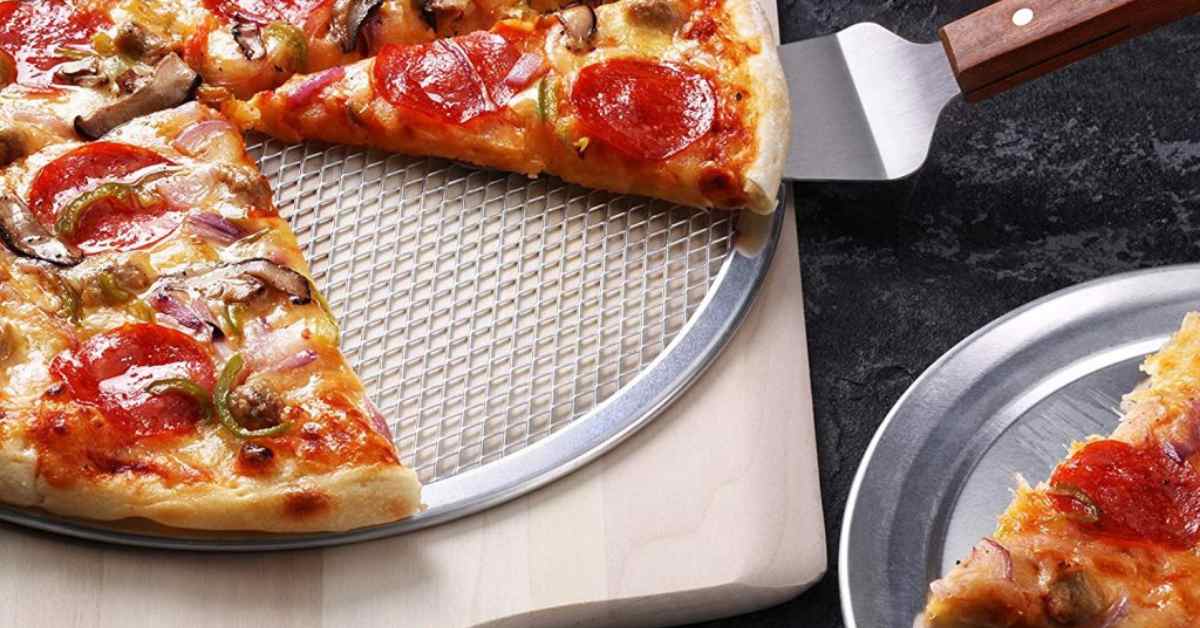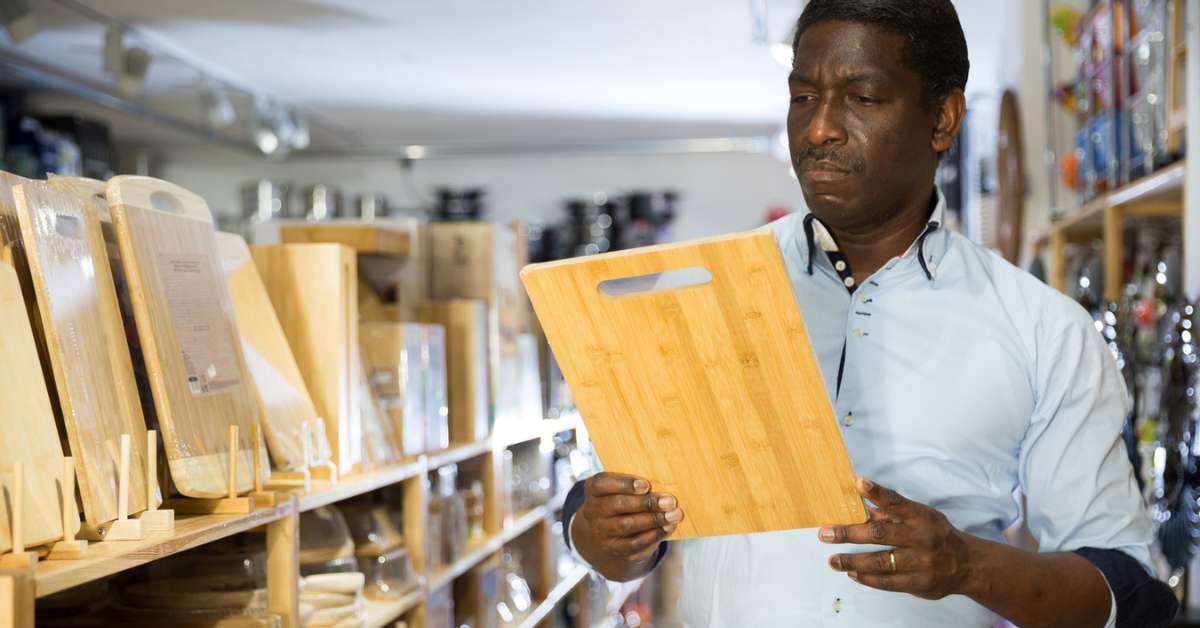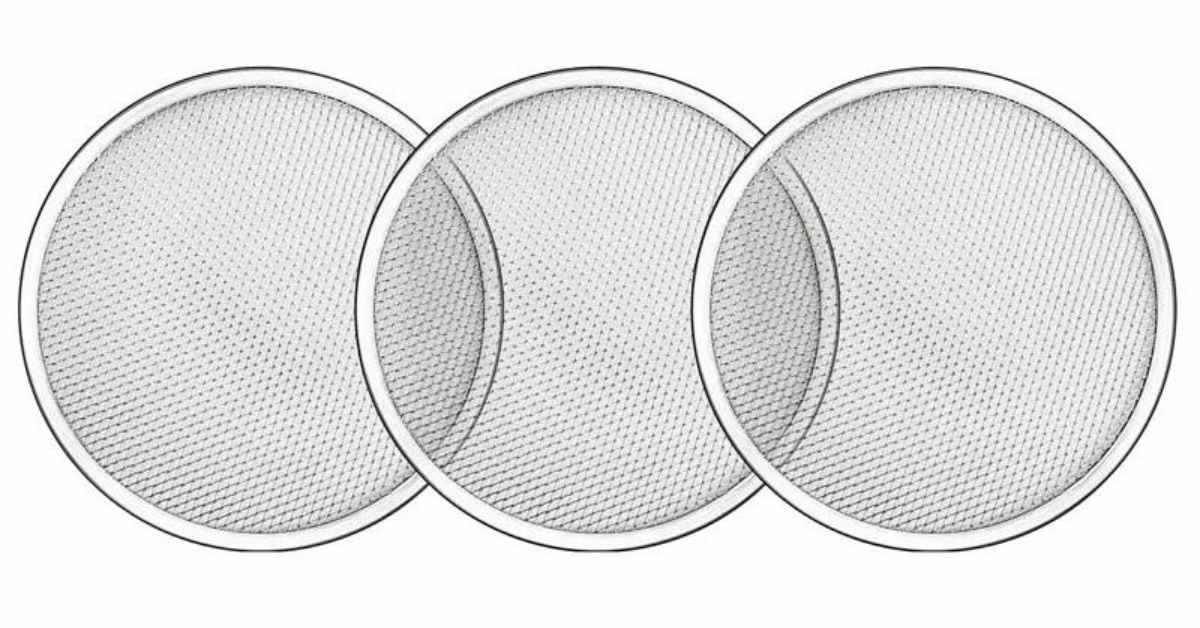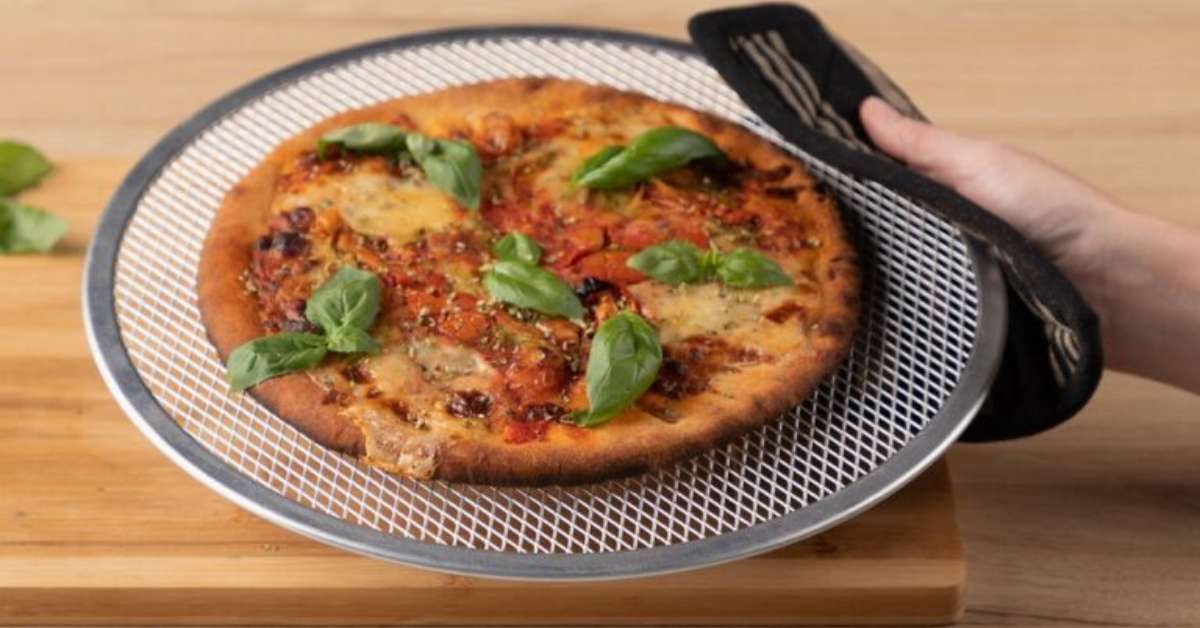Are you looking to elevate your pizza-making game? Learn how to use a pizza screen effectively with our expert guide for 2023. Whether you’re a seasoned pizzaiolo or just starting your culinary journey, mastering the art of the pizza screen can make a world of difference.
From achieving a perfectly crispy crust to evenly cooked toppings, we’ll walk you through the ins and outs of using a pizza screen to create a mouthwatering masterpiece. Dive into the details below to unleash your inner pizza artist.
Table of Contents
ToggleWhat is Pizza Screens
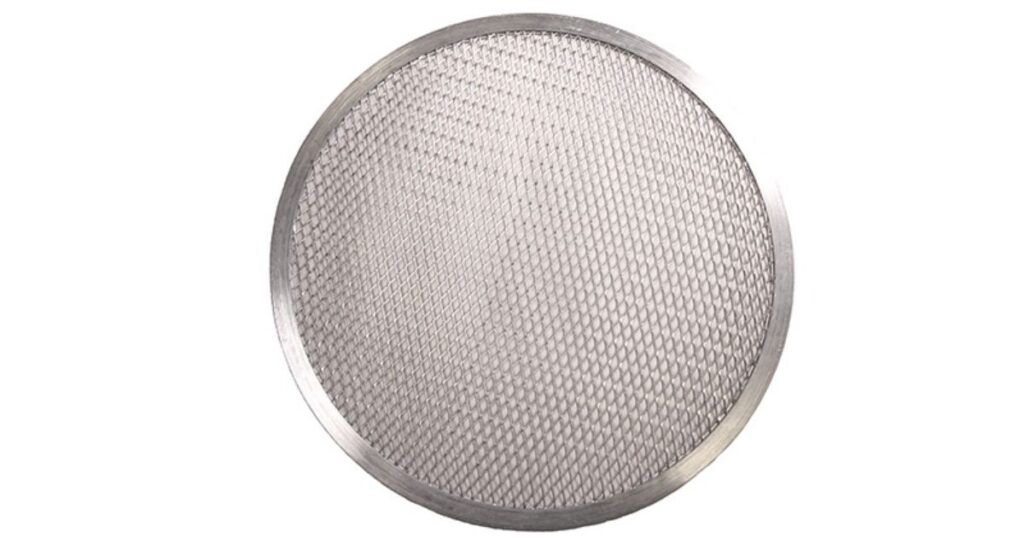
Pizza screens, often called pizza mesh or pizza pans with holes, are essential in crafting. These circular screens, typically made from aluminum, feature a mesh-like surface with evenly spaced perforations.
The primary purpose of these screens is to facilitate the circulation of hot air beneath the pizza crust while it bakes. This ingenious design promotes efficient heat distribution, ensuring the crust cooks uniformly and achieves that coveted crispiness.
Pizza screens come in various sizes, allowing you to choose one that matches your desired pizza diameter. As a versatile alternative to traditional pizza pans, these screens have become a go-to choice for achieving the perfect pie crust.
How to Prepare for Use a Pizza Screen
Setting the stage for success before embarking on your pizza-making journey using a pizza screen is crucial. Here’s a step-by-step guide to ensure you’re well-prepared:
Gather Your Ingredients: Assemble your favorite pizza dough, sauce, cheese, and toppings. Having everything ready will streamline the process.
Preheat Your Oven: Ensure your oven is preheated to the recommended temperature. A well-preheated range is essential for achieving that delightful crispy crust.
Choose the Right Size: Select a pizza screen that matches the pizza size you intend to create. The screen’s perforated surface is designed to handle specific dimensions.
Prepare the Pizza Screen: Place the pizza screen on a pizza peel or an inverted baking sheet. This will make it easier to slide the pizza onto the screen and into the oven.
Dust with Flour or Cornmeal: Lightly sprinkle flour or cornmeal onto the pizza screen. This helps prevent sticking and ensures a smooth transition from peel to oven.
Stretch Your Dough: Roll out or hand-stretch your pizza dough to fit the size of the screen. Make sure the dough is evenly distributed and reaches the edges.
With your ingredients and pizza screen ready, you’re prepared to craft your masterpiece.
How to Use a Pizza Screen
Now that you’ve prepped your ingredients and set up your pizza screen, it’s time to use it to create a delectable pizza. Follow these steps for a successful pizza-making experience:
Place the Screen: Gently transfer your stretched pizza dough onto the prepared pizza screen. Center it to ensure even cooking and prevent any overhang.
Add Sauce and Toppings: Spread your desired amount of pizza sauce over the dough, leaving a border around the edges for the crust. Then, sprinkle on your favorite cheeses and toppings.
Slide into the Oven: Carefully slide the pizza and screen onto the preheated oven rack or pizza stone. The holes in the screen will allow hot air to circulate beneath the crust, promoting even baking.
Monitor and Rotate: Keep an eye on your pizza’s progress. Depending on your oven’s heat distribution, you might need to rotate the pizza once during baking to ensure uniform browning.
Check for Doneness: After a few minutes, your pizza will start to take shape. Watch the cheese melt and bubble, and the crust turns golden brown. Use a pizza peel or spatula to lift a pizza corner and check the underside’s crispness.
Remove and Enjoy: Carefully slide the pizza screen out of the oven once your pizza is perfectly cooked. Allow the pizza to cool slightly before cutting and serving. Combining a crispy crust and delicious toppings will impress your taste buds.
A pizza screen adds a professional touch to your pizza-making process, yielding a well-cooked crust that will surely delight you. Keep experimenting with different toppings and techniques to create the ultimate pizza experience in your kitchen.
Advantages of Using a Pizza Screen
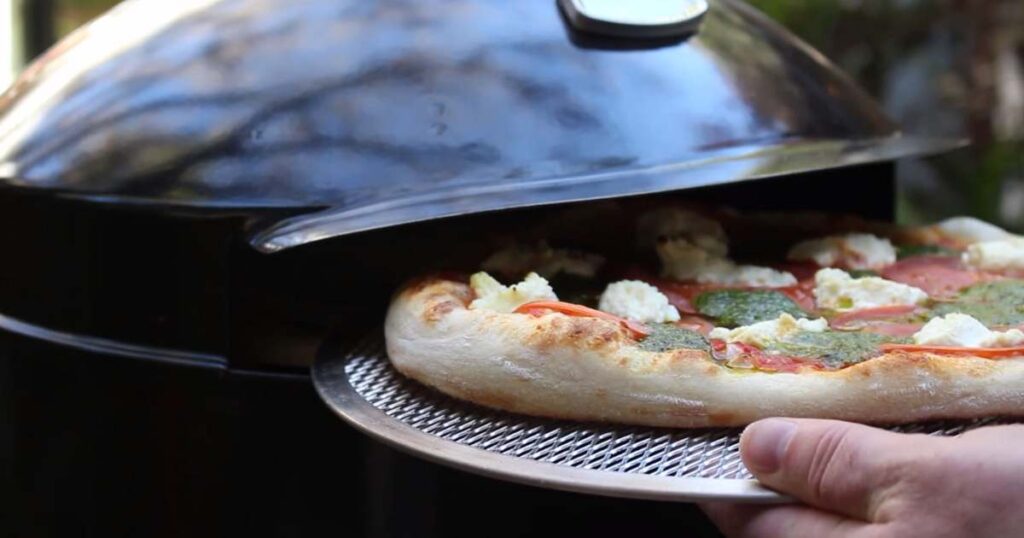
Incorporating a pizza screen into your culinary arsenal has many benefits that elevate your pizza-making endeavors. Here are some key advantages to consider:
Crispy Crust: The perforated surface of the pizza screen allows hot air to circulate beneath the crust, resulting in a uniformly crispy texture. Say goodbye to soggy or undercooked crusts.
Even Cooking: The even distribution of heat across the screen ensures that your pizza cooks evenly. This means no more unevenly melted cheese or toppings.
Quick Baking: Pizza screens expedite baking by promoting efficient heat transfer. Enjoy a perfectly cooked pizza in a shorter amount of time.
Customization: With various sizes available, you can tailor your pizza screen to match your desired pizza diameter. Experiment with different sizes for personal pizzas or larger gatherings.
Less Dough Handling: Using a pizza screen reduces the need for transferring the dough from one surface to another, minimizing the risk of deforming the dough or losing its shape.
Versatility: Pizza screens aren’t limited to just pizza. They’re also excellent for baking flatbreads, focaccia, and other baked goods that benefit from a crispy base.
User-Friendly: Even if you’re new to pizza-making, using a pizza screen is straightforward. It’s simple design makes it accessible to both beginners and seasoned cooks.
Consistent Results: Once you’ve mastered the technique, you can expect consistent, professional-quality results with every pizza you make.
By harnessing these advantages, you’ll enhance your culinary prowess and impress your family and friends with delicious, perfectly cooked pizzas that rival those from your favorite pizzeria.
Pizza Screen vs Pizza Stone: Which One is Better
When it comes to achieving the ultimate pizza crust, the debate between using a pizza screen or a pizza stone is a hot topic. Both tools offer distinct advantages, catering to different preferences and cooking styles. Let’s explore the strengths of each to help you make an informed decision:
Pizza Screen
- Crispy Crust: A pizza screen excels at creating a consistently crispy crust due to its perforated design, allowing air to circulate beneath the dough.
- Faster Cooking: Pizza screens promote efficient heat transfer, resulting in quicker cooking times than other methods.
- Ease of Use: Suitable for both novice and experienced cooks, using a pizza screen requires minimal preparation and technique.
- Uniform Results: You can expect consistent browning and even cooking throughout the pizza.
Pizza Stone
- Authentic Texture: A pizza stone mimics the effects of a brick oven, providing an original, brick-oven-like texture to the crust.
- Heat Retention: The stone’s ability to retain and radiate heat ensures a consistent temperature, leading to even cooking and beautifully browned crusts.
- Versatility: Besides pizza, pizza stones are excellent for baking bread, pastries, and other baked goods.
- Artisan Appeal: Using a pizza stone adds a touch of artisanal charm to your baking process, making it a favorite among enthusiasts.
Choosing between a pizza screen and a pizza stone depends on your culinary goals and preferences. A pizza screen is an excellent option if you prioritize convenience, quick cooking times, and a consistently crispy crust.
On the other hand, if you seek a more traditional and versatile baking surface with an authentic texture, a pizza stone might be the better fit. Whichever you choose, both tools can help you create exceptional homemade pizzas that cater to your unique taste.
How to Clean and Maintenance

Properly caring for your pizza screen ensures its longevity and consistent performance. Follow these steps to clean and maintain your pizza screen:
After each use, allow the pizza screen to cool down. Gently scrape off any remaining food particles using a soft brush or cloth. Soak the screen in warm, soapy water to remove stuck-on residues for a few minutes.
Use a non-abrasive sponge or cloth to gently scrub the surface, paying extra attention to the perforations.
Avoid harsh chemicals or abrasive pads, which can damage the screen’s finish. Rinse the screen thoroughly with clean water to remove any soap residue. Pat it dry with a clean towel, or let it air dry.
To prevent rust, ensure the screen is completely dry before storing it. Store it in a cool, dry place to avoid moisture buildup. If the screen develops stubborn stains or odors, paste baking soda and water, apply it to the colors, and gently scrub before rinsing.
Regular maintenance involves checking for any signs of wear, such as bent edges or excessive discoloration. If the screen becomes warped, gently reshape it to its original form.
By following these care and maintenance tips, you’ll keep your pizza screen in prime condition, ensuring countless delicious pizzas in the future.
Tips for Using a Pizza Screen
To make the most of your pizza screen, consider these helpful tips:
Preheat Properly: Ensure your oven is fully preheated before placing the pizza screen inside. This helps achieve that coveted crispy crust.
Use Light Toppings: Opt for lighter toppings to prevent excess moisture, which can affect the crust’s crispiness.
Rotate if Needed: Depending on your oven’s heat distribution, rotating the pizza halfway through cooking can help ensure even browning.
Monitor Carefully: Keep a close eye on your pizza’s progress to prevent overcooking. The screen promotes faster cooking so a few minutes can make a difference.
Experiment with Parchment: Placing parchment paper on the screen before adding your dough can further prevent sticking.
Cool Before Cutting: Allow your pizza to cool slightly before cutting. This preserves the integrity of the crust and prevents toppings from sliding off.
Adjust Cooking Time: Since pizza screens facilitate quicker baking, be prepared to adjust cooking times compared to traditional pans or stones.
By incorporating these tips into your pizza-making routine, you’ll harness the full potential of your pizza screen, creating delectable pies that delight your palate.
Frequently Asked Questions
How do you use a pizza-baking screen?
Using a pizza baking screen involves placing your stretched pizza dough onto the screen, adding sauce and toppings, and then sliding it into a preheated oven. The screen’s perforations help achieve a crispy crust by allowing air to circulate beneath the dough.
What is the point of pizza screens?
Pizza screens promote even cooking by allowing hot air to flow beneath the crust, resulting in a uniformly crispy texture. They’re excellent for achieving quick cooking times and consistent results.
Is a pizza screen better than a pan?
Both tools have their advantages. A pizza screen excels at achieving a crispy crust and faster cooking times, while a pan may be better for containing excess liquids from toppings.
Do pizza screens need to be seasoned?
Unlike pizza stones, pizza screens do not need to be seasoned. However, regular cleaning and maintenance are essential for their performance and longevity.
Do you need to oil a pizza screen?
Oiling a pizza screen is unnecessary, but lightly dusting it with flour or cornmeal can help prevent sticking and facilitate easy pizza transfer to the oven.

